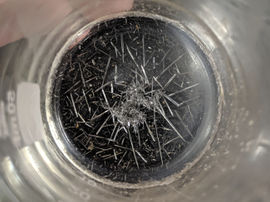Erythritol tetranitrate
 Crystals of ETN
| |
| Names | |
|---|---|
| IUPAC name
[(2R,3R)-1,3,4-Trinitrooxybutan-2-yl] nitrate
| |
| Systematic IUPAC name
Erythritol tetranitrate | |
| Other names
Meso-1,2,3,4-tetrakis-nitrooxy-butane
Erythrityl tetranitrate ETN Tetra-O-nitro-erythritol | |
| Identifiers | |
| Jmol-3D images | Image |
| |
| Properties | |
| C4H6N4O12 | |
| Molar mass | 302.11 g/mol |
| Appearance | White solid |
| Odor | Odorless |
| Density | 1.827 g/cm3 |
| Melting point | 61 °C (142 °F; 334 K) |
| Boiling point | 160 °C (320 °F; 433 K) (decomposes) |
| Insoluble | |
| Solubility | Reacts with alkalis Soluble in acetone, diethyl ether, ethanol, methanol, isopropanol |
| Hazards | |
| Related compounds | |
| Related compounds
|
Methyl nitrate Ethylene glycol dinitrate Nitroglycerin |
| Except where otherwise noted, data are given for materials in their standard state (at 25 °C [77 °F], 100 kPa). | |
| Infobox references | |
Erythritol tetranitrate or ETN is an explosive compound. Unlike other explosive materials, such as TNT or PETN, ETN is much easier to manufacture and has positive oxygen balance, which gives it a better performance.
Contents
Properties
Chemical
ETN is about 3 times more sensitive than PETN and is more sensitive to friction than the former mentioned compound. The decomposition of ETN is oxygen positive:
- C4H6N4O12 → 4 CO2 + 3 H2O + N2 + 3/2 O2
Mixing ETN with an oxygen negative explosive material in the best ratio, improves the performance of both materials.
Physical
Erythritol tetranitrate is an odorless white solid compound. It is insoluble in water, but very soluble in acetone and other ketones, as well as most alcohols and ethers. Its solubility in alcohol decreases as the alcohol weight increases.
Explosive
ETN has a high velocity of detonation (VOC) of 8000–8100 m/s, at a density of 1.6 g/cm3. As an explosive, ETN is somewhat sensitive to shock and friction, though less so than most common sensitive explosives. However, it can be reliably detonated in many cases via thermal shock in the presence of certain metals, especially aluminum or iron. Thus, it is important not to store ETN in the presence of aluminum or other metals.
Erythritol tetranitrate is known for having a very long shelf life, samples stored at room temperature show no signs of decomposition even after after four years.
Availability
Erythritol tetranitrate is not sold by almost any entities, even big chemical suppliers like Sigma-Aldrich don't have it in their stock.
Preparation
Erythritol tetranitrate can be prepared by nitrating erythritol using a nitrating mixture. It can be extracted from the reaction product by dissolving it in ethanol and then adding water, which causes it to precipitate.[1]
It's recommended to obtain the final product as powder rather than large crystals, as it's less sensitive.
Projects
- Make blasting charge
Handling
Safety
Erythritol tetranitrate is sensitive to strong shock and friction, and may explode. If consumed, it results in severe headaches, due to being a strong vasodilator, property seen in other nitrated organic compounds.
Storage
ETN should be stored in closed non-metal spark free containers, preferably in special cabinets. For safety and legal reasons avoid storing large amounts. Try to use it as soon as you make it.
Disposal
ETN can be neutralized with an excess solution of sodium hydroxide, at low temperatures.
References
Relevant Sciencemadness threads
- Chemical pages without CAS Registry Number
- Articles without EBI source
- Chemical pages without ChemSpiderID
- Chemical pages without DrugBank identifier
- Articles without KEGG source
- Articles without InChI source
- Articles without UNII source
- Articles containing unverified chemical infoboxes
- Chemical compounds
- Organic compounds
- Nitrates
- Nitrated organic compounds
- Energetic materials
- High explosives
- Secondary explosives
- Things that can kill you very quickly